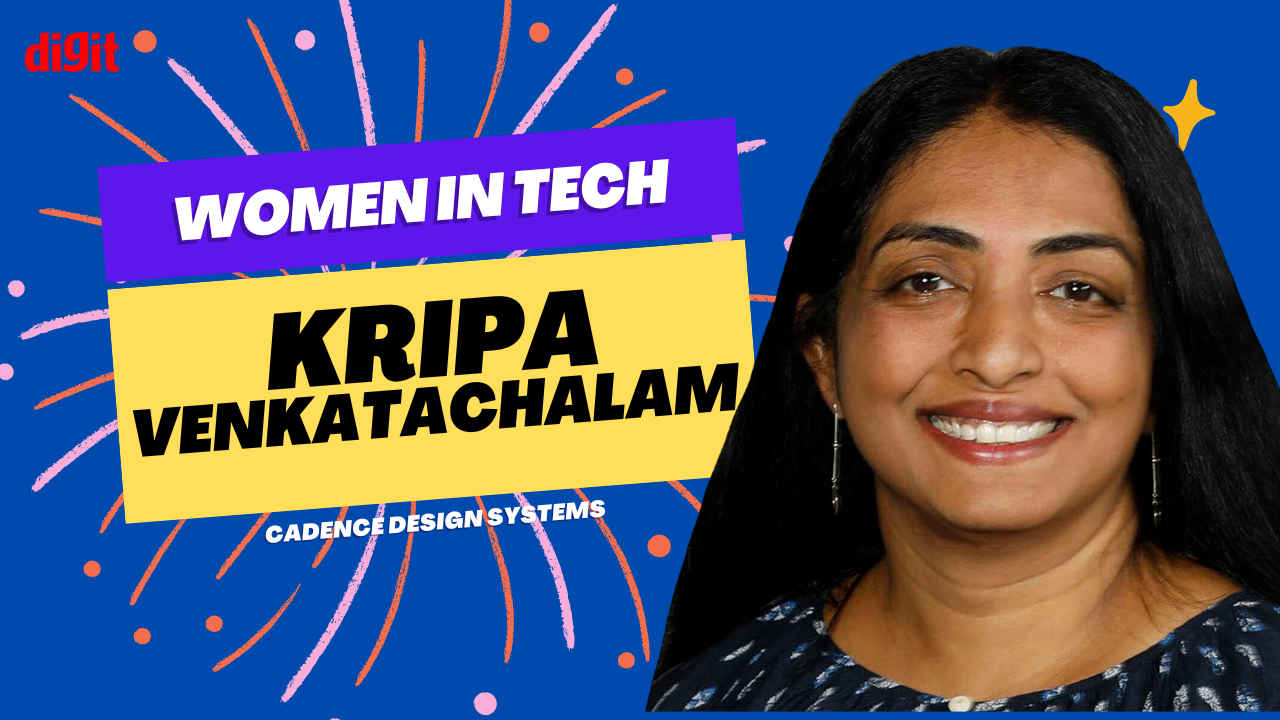Women’s Day 2024: Cadence’s Kripa Venkatachalam on Women in Tech

In the intricately detailed arena of the semiconductor industry, where high precision electronics give rise to innovations of our digital world, Kripa Venkatachalam’s voice resonates with breaking barriers and redefining norms.
 Survey
Survey“My career began with building PCBs at Analog Devices, and a pivotal moment in my career was working on an early version of GPS technology,” Venkatachalam reminisces. This initial spark led her down the path of innovation, from delving into the nuances of chip design to spearheading advancements in signal processing. Her journey is not just a tale of personal achievement but a testament to the relentless pursuit of excellence.

Kripa Venkatachalam, Vice President of Field Engineering at Cadence Design Systems, stands as a beacon of inspiration, not just for her groundbreaking work but for her unwavering commitment to fostering an environment where women thrive in technology. As we celebrate International Women’s Day 2024, we interviewed Venkatachalam to get an insight into her challenges and triumphs while daring to make a difference in a traditionally male-dominated profession. Edited excerpts follow:
Q) Tell us about your journey through the semiconductor industry?
For the first decade of my career, I worked as a chip designer, contributing to advances in signal processing. I had the opportunity to work with very smart people and, in the process, had the opportunity to work on all aspects of semiconductor design. The following ten years saw a shift in my career path; I transitioned into customer-facing roles, ventured into product management, and explored field engineering extensively. This shift broadened my skill set and allowed me to actively engage with clients, understand market dynamics, and contribute to the strategic aspects of semiconductor solutions.
No journey is interesting without challenges, and mine has been no different. This was accentuated by the fact that core technical fields such as semiconductors have traditionally been male-dominated. My technical capability along with my resilience and determination, allowed me to add value in every role I have taken on. Throughout my journey, my love for technology, combined with a commitment to excellence, has been my driving force. In addition, I have been fortunate to have supportive managers and mentors who have been instrumental in helping break barriers. Every challenge, whether technical or gender-related, has been an opportunity to learn, adapt, and thrive.
Q) Any examples of empowering women colleagues at Cadence?
I’m proud to be part of an organisation that is committed to fostering an inclusive environment. One of the key initiatives in terms of programs for women was the Cadence Women Conference (CWC), held in several regions worldwide, including India, in 2022 and 2023. I had the privilege of leading this Conference in India as the General Chair. It was a truly rewarding experience as it allowed me to contribute to a unique platform that celebrated women’s achievements while also providing development opportunities through workshops and keynotes.
Cadence organises women’s roundtables regularly to provide a platform for women employees to share their challenges, successes, and developmental needs. What makes us unique is our closed-loop process that follows these discussions, ensuring that the feedback gathered is translated into actionable initiatives whenever possible.
Cadence has a robust global mentoring program specifically designed for women. I find it immensely fulfilling to invest my time in mentoring several talented individuals to contribute to their professional growth and development.
Q) As Vice President of Field Engineering at Cadence, what are some of the key innovations or projects you’ve spearheaded?
I lead a dynamic technical field team dedicated to assisting our customers in bringing innovations to the market and ensuring their success.
One significant area of focus has been our engagement with AI products. We’ve been actively evangelising the value that AI-based solutions can bring to productivity and quality in the semiconductor space. By helping to proliferate these innovations with customers, we not only position our customers at the forefront of technological advancements but also contribute to the industry’s overall evolution.
Another aspect of my team’s contributions is that the team serves as the voice of the customer within Cadence. The team’s strategic role as an intensely customer-facing organisation enables us to identify key insights from our customers and relay valuable inputs to influence our product direction. We enhance the quality of our products, ensuring they align seamlessly with the evolving needs of our customers. Ultimately, these efforts contribute to an improved overall customer experience, reinforcing Cadence’s position as a leader in the semiconductor industry.
Q) Why is gender diversity particularly crucial in the semiconductor industry?
First of all, there is a significant shortage of semiconductor talent on a global scale. According to the Semiconductor Industry Association, by 2030, approximately 58% or 67,000 of the projected new jobs in the US alone are at risk of being unfilled. Underutilizing half the world’s population in an environment where there is a significant dearth of talent is a strategic mistake.
Empowering women to join the semiconductor ecosystem is not just about closing the gender gap; it is also about leveraging diverse talents to propel the industry forward. Diverse teams contribute to diverse thought processes, which will result in a more comprehensive understanding of the market and customer needs, ultimately driving innovation and enhancing economic growth.
To close the gender gap, we need to make a two-pronged effort. Firstly, we must identify the triggers that cause women to leave the workforce. Typically, attrition is caused by key life events, such as marriage, childbirth, and elder care in the family. To retain women in the workforce, companies and families must take measures to provide logistical support during these critical stages of a woman’s life. Secondly, we need to actively promote inclusivity and equity in the workplace. This involves creating mentorship programs, fostering a supportive work environment, and implementing initiatives to attract and retain women in the field.
Q) How has your educational background in electrical and electronics engineering and computer engineering shaped your approach to leadership?
Education, particularly in engineering, teaches valuable problem-solving skills. It encourages individuals to explore innovative ways to find creative solutions. In the semiconductor industry, where technological challenges are abundant, the mindset to tackle complex problems head-on is crucial. The can-do attitude instilled through engineering education is particularly vital as it fuels resilience in the face of challenges and instils a mindset that believes every problem is an opportunity to innovate.
Q) As a successful professional and a mother of two, how do you balance the demands of your career with personal and family life? What advice would you share with others?
Firstly, I look forward to the day when questions about work-life balance are directed to both men and women, as achieving balance in both personal and professional spheres is a challenge not just reserved for women. One key aspect of managing this delicate balance is prioritisation. Recognizing that we cannot do everything and embracing the power of saying ‘no’ is essential. It is a crucial skill in maintaining focus and effectiveness in both career and family life.
It’s important to remember that we don’t have to be present for every single event or activity, either at work or at home. It’s simply not possible to attend every recital, parent-teacher meeting, or work call. However, missing out on certain events doesn’t make us inadequate employees or mothers. It’s important to acknowledge this reality and let go of any guilt associated with missing certain commitments.
Finally, it’s essential to activate our support circle. Establishing a network of support, both at home and in the workplace, can significantly alleviate the challenges of juggling career and family responsibilities. Asking for help when needed is a strength, not a weakness.
Q) What changes do you hope to see regarding women’s participation and leadership in the tech industry, particularly in India?
In India, it’s encouraging to see the trend of a high percentage of women entering the workforce. The entry funnel is healthy, reflecting a positive shift in societal attitudes towards gender inclusivity and opportunities for women in technology. However, as we look at the mid- to senior-level workforce with 10-20 years of experience, there is a noticeable decline in the representation of women. To address this, we need concerted efforts to create an environment that supports and retains experienced women professionals, even as they navigate familial responsibilities. Companies can play a pivotal role in implementing policies that facilitate work-life balance, mentorship programs, and avenues for skill development, ensuring that women can progress in their careers seamlessly.
At Cadence, we have several programs to nurture women at the workplace, including “Returnship” where we welcome back women who are re-entering the workforce after a break by providing necessary training & support to ease the challenges associated with their return. The above said, I would be amiss if I don’t mention the important role every individual’s decision has in this societal megatrend. It is important for women and their families not to view a woman’s employment and career fulfilment as “optional” or “lower priority.” I have often seen that several women choose to quit the workforce as it makes it “simpler” for the rest of the family, and many regret this choice in later years. Taking a long-term view of what provides contentment and satisfaction and addressing short-term needs within that broader long-term framework is key to sustainably retaining women in the workforce.
Q) What advice would you give to young women aspiring to enter the semiconductor industry or the tech field in general?
The semiconductor industry is growing fast, presenting a multitude of opportunities for those who are passionate about innovation, making it a great time to pursue a career in the field.
To young women and men alike, my advice is to stay curious, ask questions and be on a path of continuously learning. Networking and mentorship play crucial roles, so seek out opportunities to connect with professionals in the field, and don’t be afraid to step out of your comfort zone. Be resilient in the face of challenges, as overcoming obstacles is an integral part of professional growth. Being resilient and staying adaptable is the key to success as the technology industry evolves rapidly.
Finally, I do have one specific piece of advice for women aspiring to enter tech – It is very important to build your support network in your family, community, and at your workplace. Please unhesitantly ask for help where you need support. You don’t have to do this alone.
Q) What is your vision for the future of this field, and how do you see women playing a role in shaping this future?
The semiconductor industry has been witnessing robust growth, with a CAGR of 12.2% during 2022-2029, which reflects the increasing demand for advanced technologies across various sectors. We have a confluence of several generational megatrends, such as AI/ML, high-performance computing, 5G, automotive, and quantum computing, driving this demand sustainably.
Semiconductors are the backbone of these generational growth drivers. Industry-shaping innovation is at the heart of what we do and will remain so for the foreseeable future. Working in technology, with abundant opportunity for innovation, alongside flexible work hours, provides a great opportunity for anyone with competing life priorities, especially women, a great avenue for balancing professional and personal life.
As we discussed before, recruiting from all possible pools of diverse talent is a business imperative. Women are a big part of this talent pool. I believe the industry dynamics are well-suited for women to be an equal part of our workforce.
Jayesh Shinde
Executive Editor at Digit. Technology journalist since Jan 2008, with stints at Indiatimes.com and PCWorld.in. Enthusiastic dad, reluctant traveler, weekend gamer, LOTR nerd, pseudo bon vivant. View Full Profile